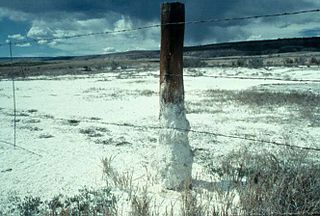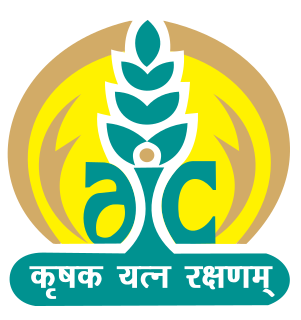
Agriculture is the practice of cultivating plants and livestock. Agriculture was the key development in the rise of sedentary human civilization, whereby farming of domesticated species created food surpluses that enabled people to live in cities. The history of agriculture began thousands of years ago. After gathering wild grains beginning at least 105,000 years ago, nascent farmers began to plant them around 11,500 years ago. Pigs, sheep, and cattle were domesticated over 10,000 years ago. Plants were independently cultivated in at least 11 regions of the world. Industrial agriculture based on large-scale monoculture in the twentieth century came to dominate agricultural output, though about 2 billion people still depended on subsistence agriculture.

The Dust Bowl was a period of severe dust storms that greatly damaged the ecology and agriculture of the American and Canadian prairies during the 1930s; severe drought and a failure to apply dryland farming methods to prevent the aeolian processes caused the phenomenon. The drought came in three waves: 1934, 1936, and 1939–1940, but some regions of the High Plains experienced drought conditions for as many as eight years.

Soil salinity is the salt content in the soil; the process of increasing the salt content is known as salinization. Salts occur naturally within soils and water. Salination can be caused by natural processes such as mineral weathering or by the gradual withdrawal of an ocean. It can also come about through artificial processes such as irrigation and road salt.

Organic farming is an agricultural system that uses fertilizers of organic origin such as compost manure, green manure, and bone meal and places emphasis on techniques such as crop rotation and companion planting. It originated early in the 20th century in reaction to rapidly changing farming practices. Certified organic agriculture accounts for 70 million hectares globally, with over half of that total in Australia. Organic farming continues to be developed by various organizations today. Biological pest control, mixed cropping and the fostering of insect predators are encouraged. Organic standards are designed to allow the use of naturally-occurring substances while prohibiting or strictly limiting synthetic substances. For instance, naturally-occurring pesticides such as pyrethrin and rotenone are permitted, while synthetic fertilizers and pesticides are generally prohibited. Synthetic substances that are allowed include, for example, copper sulfate, elemental sulfur and Ivermectin. Genetically modified organisms, nanomaterials, human sewage sludge, plant growth regulators, hormones, and antibiotic use in livestock husbandry are prohibited. Organic farming advocates claim advantages in sustainability, openness, self-sufficiency, autonomy and independence, health, food security, and food safety.

The Weather Channel (TWC) is an American pay television channel owned by Weather Group, LLC, a subsidiary of Allen Media Group. The channel's headquarters are in Atlanta, Georgia. Launched on May 2, 1982, the channel broadcasts weather forecasts and weather-related news and analysis, along with documentaries and entertainment programming related to weather. A sister network, Weatherscan, is a digital cable and satellite service that offers 24-hour automated local forecasts and radar imagery. The Weather Channel also produces outsourced weathercasts, notably for RFD-TV.

Intensive agriculture, also known as intensive farming, conventional, or industrial agriculture, is a type of agriculture, both of crop plants and of animals, with higher levels of input and output per unit of agricultural land area. It is characterized by a low fallow ratio, higher use of inputs such as capital and labour, and higher crop yields per unit land area.

Agricultural productivity is measured as the ratio of agricultural outputs to inputs. While individual products are usually measured by weight, which is known as crop yield, varying products make measuring overall agricultural output difficult. Therefore, agricultural productivity is usually measured as the market value of the final output. This productivity can be compared to many different types of inputs such as labour or land. Such comparisons are called partial measures of productivity.

In finance, a futures contract is a standardized legal agreement to buy or sell something at a predetermined price at a specified time in the future, between parties not known to each other. The asset transacted is usually a commodity or financial instrument. The predetermined price the parties agree to buy and sell the asset for is known as the forward price. The specified time in the future—which is when delivery and payment occur—is known as the delivery date. Because it is a function of an underlying asset, a futures contract is a derivative product.

DTN, previously known as Telvent DTN, Data Transmission Network and Dataline, is a private company based in Burnsville, Minnesota that specializes in subscription-based services for the analysis and delivery of real-time weather, agricultural, energy, and commodity market information. As of 2018 the company has approximately 600,000 subscribers, mostly in the United States. DTN is known for its accurate meteorological forecasting and large network of weather stations, its market analysis services, and its early use of radio and satellite systems to transmit reports to its Midwestern consumers. DTN also operates The Progressive Farmer magazine. DTN was previously owned by Telvent and Schneider Electric, and since 2017 has been owned by Zurich-based TBG.
Weather derivatives are financial instruments that can be used by organizations or individuals as part of a risk management strategy to reduce risk associated with adverse or unexpected weather conditions. Weather derivatives are index-based instruments that usually use observed weather data at a weather station to create an index on which a payout can be based. This index could be total rainfall over a relevant period—which may be of relevance for a hydro-generation business—or the number where the minimum temperature falls below zero which might be relevant for a farmer protecting against frost damage.
Crop insurance is purchased by agricultural producers, and subsidized by the federal government, to protect against either the loss of their crops due to natural disasters, such as hail, drought, and floods, or the loss of revenue due to declines in the prices of agricultural commodities. The two general categories of crop insurance are called crop-yield insurance and crop-revenue insurance. On average, the federal government subsidizes 62 percent of the premium. In 2019, crop insurance policies covered almost 380 million acres. Major crops are insurable in most counties where they are grown, and approximately 90% of U.S. crop acreage is insured under the federal crop insurance program. Four crops—corn, cotton, soybeans, and wheat— typically account for more than 70% of total enrolled acres. For these major crops, a large share of plantings is covered by crop insurance.

Agricultural wastewater treatment is a farm management agenda for controlling pollution from confined animal operations and from surface runoff that may be contaminated by chemicals in fertilizer, pesticides, animal slurry, crop residues or irrigation water. Agricultural wastewater treatment is required for continuous confined animal operations like milk and egg production. It may be performed in plants using mechanized treatment units similar to those used for industrial wastewater. Where land is available for ponds, settling basins and facultative lagoons may have lower operational costs for seasonal use conditions from breeding or harvest cycles. Animal slurries are usually treated by containment in anaerobic lagoons before disposal by spray or trickle application to grassland. Constructed wetlands are sometimes used to facilitate treatment of animal wastes.

Agriculture is the largest employment sector in Bangladesh, making up 14.2 percent of Bangladesh's GDP in 2017 and employing about 42.7 percent of the workforce. The performance of this sector has an overwhelming impact on major macroeconomic objectives like employment generation, poverty alleviation, human resources development, food security, and other economic and social forces. A plurality of Bangladeshis earn their living from agriculture. Due to a number of factors, Bangladesh's labour-intensive agriculture has achieved steady increases in food grain production despite the often unfavorable weather conditions. These include better flood control and irrigation, a generally more efficient use of fertilisers, as well as the establishment of better distribution and rural credit networks.

Agriculture in Kenya dominates Kenya's economy. 15–17 percent of Kenya's total land area has sufficient fertility and rainfall to be farmed, and 7–8 percent can be classified as first-class land. In 2006, almost 75 percent of working Kenyans made their living by farming, compared with 80 percent in 1980. About one-half of Kenya's total agricultural output is non-marketed subsistence production.

Agriculture Insurance Company of India Limited (AIC) a nationalised insurance company under the ownership of Ministry of Finance, Government of India that offers yield-based and weather-based crop insurance programs in almost 500 districts of India. It covers almost 20 million farmers, making it the biggest crop insurer in the world in number of farmers served. Agriculture Insurance Company of India Limited is a development finance institution headquartered out of New Delhi, India
Glacier Media is a Canadian business information and media products company. It provides news, market information and sector-specific data within North America and internationally.

.

Agricultural technology or agrotechnology is the use of technology in agriculture, horticulture, and aquaculture with the aim of improving yield, efficiency, and profitability. Agricultural technology can be products, services or applications derived from agriculture that improve various input/output processes.

Food prices refer to the average price level for food across countries, regions and on a global scale. Food prices have an impact on producers and consumers of food.
Index-based insurance, also known as index-linked insurance or, simply, index insurance, is primarily used in agriculture. Because of the high cost of assessing losses, traditional insurance based on paying indemnities for actual losses incurred is usually not viable, particularly for smallholders in developing countries. With index-based insurance, payouts are related to an “index” that is closely correlated to agricultural production losses, such as one based on rainfall, yield or vegetation levels. Payouts are made when the index exceeds a certain threshold, often referred to as a “trigger”. Index-based insurance is not therefore designed to protect farmers against every peril, but only where there is a widespread risk that significantly influences a farmer’s livelihood. Many such indices now make use of satellite imagery.














